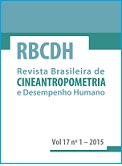Spatio-temporal characteristics of hurdle runs and ergometric tests during athletic preparation
DOI:
https://doi.org/10.1590/1980-0037.2015v17n1p51Resumen
The main goal of this study was to assess the appropriateness of both ergometric and modified hurdles tests for an annual cycle of hurdlers who were working on mastering the 400 m distance. Nine Polish hurdlers (personal best: 54.46±2.16 s, age: 20.67±1.87 years) were chosen as the research participants. In each of two mastering periods in the research, an ergometric test and a specific test were implemented during a hurdle run. In February, an interval ergometric test (5×6 s) and an interval hurdle test (IHT) were performed. Additionally, in May, a classic Wingate test and a 200 m hurdle run were introduced. With regard to the ergometric tests, we assessed the following measurements: maximum power (Pmax) and mean power (P×) reached in five repetitions as well as total work (Wtotal) performed in five attempts. The Mann-Whitney test was used to distinguish between the athletic test results obtained in the preparation period outlined above and those obtained in the first period. Lactate (LA) concentrations were assessed with the Chisquare test. Moreover, Spearman’s rank correlation coefficients were used in the analysis. The achieved study results indicate the lack of significant differentiation of the ergometric test parameters (p? 0.05). The spatial structure of both specific tests (5×2 H v. 200 m H) was similar given that the first and the second parts of both hurdle races and the number of steps taken were similar. The basic parameters of the ergometric tests did not exhibit any relationship with the recommended record time achieved for the 400 m hurdle run
Descargas
Publicado
Número
Sección
Licencia

Direitos Autorais para artigos publicados nesta revista são do autor, com direitos de primeira publicação para a revista. Em virtude da aparecerem nesta revista de acesso público, os artigos são de uso gratuito, com atribuições próprias, em aplicações educacionais e não-comerciais, desde que seja dada a atribuição. Esta obra foi licenciada com uma Licença Creative Commons Atribuição 4.0 Internacional - CC BY


